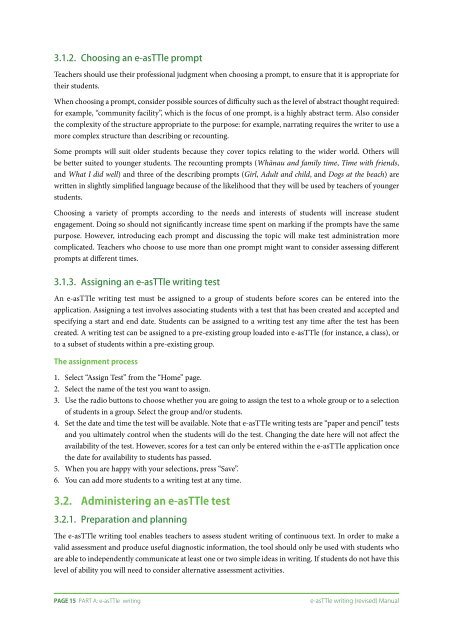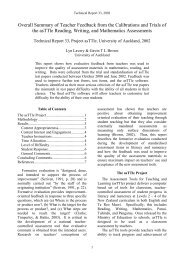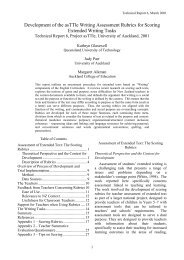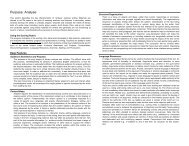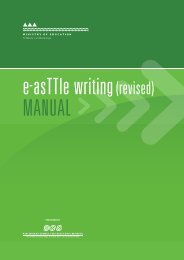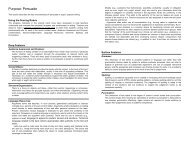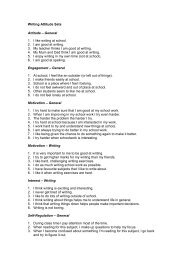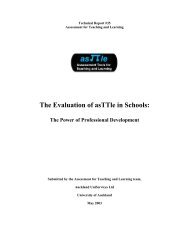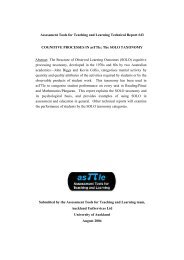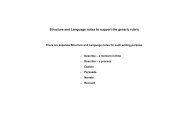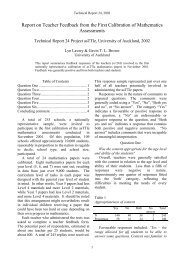e-asTTle writing (revised) Manual 2012.pdf
e-asTTle writing (revised) Manual 2012.pdf
e-asTTle writing (revised) Manual 2012.pdf
Create successful ePaper yourself
Turn your PDF publications into a flip-book with our unique Google optimized e-Paper software.
3.1.2.Choosing an e-<strong>asTTle</strong> promptTeachers should use their professional judgment when choosing a prompt, to ensure that it is appropriate fortheir students.When choosing a prompt, consider possible sources of difficulty such as the level of abstract thought required:for example, “community facility”, which is the focus of one prompt, is a highly abstract term. Also considerthe complexity of the structure appropriate to the purpose: for example, narrating requires the writer to use amore complex structure than describing or recounting.Some prompts will suit older students because they cover topics relating to the wider world. Others willbe better suited to younger students. The recounting prompts (Whānau and family time, Time with friends,and What I did well) and three of the describing prompts (Girl, Adult and child, and Dogs at the beach) arewritten in slightly simplified language because of the likelihood that they will be used by teachers of youngerstudents.Choosing a variety of prompts according to the needs and interests of students will increase studentengagement. Doing so should not significantly increase time spent on marking if the prompts have the samepurpose. However, introducing each prompt and discussing the topic will make test administration morecomplicated. Teachers who choose to use more than one prompt might want to consider assessing differentprompts at different times.3.1.3.Assigning an e-<strong>asTTle</strong> <strong>writing</strong> testAn e-<strong>asTTle</strong> <strong>writing</strong> test must be assigned to a group of students before scores can be entered into theapplication. Assigning a test involves associating students with a test that has been created and accepted andspecifying a start and end date. Students can be assigned to a <strong>writing</strong> test any time after the test has beencreated. A <strong>writing</strong> test can be assigned to a pre-existing group loaded into e-<strong>asTTle</strong> (for instance, a class), orto a subset of students within a pre-existing group.The assignment process1.2.3.4.5.6.Select “Assign Test” from the “Home” page.Select the name of the test you want to assign.Use the radio buttons to choose whether you are going to assign the test to a whole group or to a selectionof students in a group. Select the group and/or students.Set the date and time the test will be available. Note that e-<strong>asTTle</strong> <strong>writing</strong> tests are “paper and pencil” testsand you ultimately control when the students will do the test. Changing the date here will not affect theavailability of the test. However, scores for a test can only be entered within the e-<strong>asTTle</strong> application oncethe date for availability to students has passed.When you are happy with your selections, press “Save”.You can add more students to a <strong>writing</strong> test at any time.3.2.3.2.1.Administering an e-<strong>asTTle</strong> testPreparation and planningThe e-<strong>asTTle</strong> <strong>writing</strong> tool enables teachers to assess student <strong>writing</strong> of continuous text. In order to make avalid assessment and produce useful diagnostic information, the tool should only be used with students whoare able to independently communicate at least one or two simple ideas in <strong>writing</strong>. If students do not have thislevel of ability you will need to consider alternative assessment activities.Page 15 Part A: e-<strong>asTTle</strong> <strong>writing</strong>e-<strong>asTTle</strong> <strong>writing</strong> (<strong>revised</strong>) <strong>Manual</strong>


